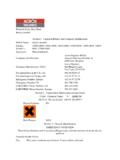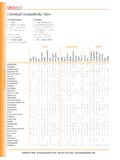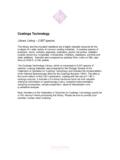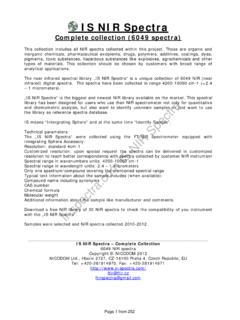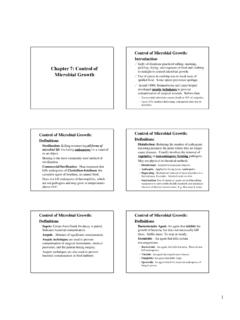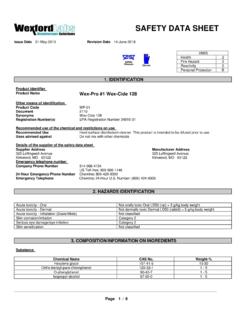Transcription of MATERIAL SAFETY DATA SHEET 1 Goof Off 2
1 MATERIAL SAFETY data SHEET Page: 1. Goof Off 2. Flammability Instability 1 Printed: 06/22/2009. Revision: 03/30/2009. 1 Supercedes Revision: 03/04/2009. Health Date Created: 03/04/2009. Special 1. Product and Company Identification Product Code: 2465. Product Name: Goof Off 2. Manufacturer Information Company Name: W. M. Barr 2105 Channel Avenue Memphis, TN 38113. Phone Number: (901)775-0100. Emergency Contact: 3E 24 Hour Emergency Contact (800)451-8346. Information: Barr Customer Service (800)398-3892. Web site address: Preparer Name: Barr EHS Dept (901)775-0100. Intended Use: Multi-Purpose Remover for grease, tar, ink, paint, adhesive, etc. Synonyms FG641 TEMP, FG642 TEMP, FG644 TEMP, FG659, FG641, FG642, FG644, FG659S. 2. Hazards Identification GHS Precaution Phrases Avoid breathing mist/vapors/spray.
2 Wash hands thoroughly after handling. Emergency Overview WARNING: Eye and Skin Irritant. Harmful if Swallowed. OSHA Regulatory Status: This MATERIAL is classified as hazardous under OSHA regulations. Health Hazards (Acute and Chronic). This MATERIAL has not been tested as a whole for health effects. Effects listed are those of the individually listed ingredients in this msds. Eyes: May cause severe irritation. May cause moderate corneal injury. Effects may include discomfort or pain, and redness. Effects may be slow to heal. Skin: Brief contact may cause slight skin irritation with local redness. Repeated exposure may cause irritation, even a burn. May cause more severe response on covered skin (under clothing, gloves). Inhalation: When used as directed, the consumer is not expected to experience any exposure effects.
3 Excessive exposure may cause irritation to the upper respiratory tract. Symptoms may include a headache, dizziness, or nausea. Ingestion: Moderately toxic if swallowed. Small amounts swallowed incidentally as a result of normal handling operations are not likely to cause injury. However, swallowing larger amounts may cause injury. Licensed to Barr and Company GHS format MATERIAL SAFETY data SHEET Page: 2. Printed: 06/22/2009. Goof Off 2 Revision: 03/30/2009. Supercedes Revision: 03/04/2009. Target Organs: Blood (Hemolysis), Kidneys, Liver, Central Nervous System. Primary Routes of Entry: Inhalation, Ingestion Signs and Symptoms Of Exposure See Potential Health Effects. Medical Conditions Generally Aggravated By Exposure None known. 3. Composition/Information on Ingredients Hazardous Components (Chemical Name) CAS # Concentration 1.
4 Ethanol, 2-Butoxy- {Ethylene glycol n-butyl 111-76-2 %. ether, (a glycol ether)}. 2. Benzenemethanol { benzyl alcohol} 100-51-6 %. 3. Tall oil, potassium salt 68647-71-2 %. 4. Diethylene glycol monobutyl ether 112-34-5 %. {2-(2-Butoxyethoxy)ethanol {(a glycol ether)}. 5. Propylene glycol phenyl ether {(not 313)} 770-35-4 %. 4. First Aid Measures Emergency and First Aid Procedures Skin: Remove contaminated clothing. Immediately wash skin thoroughly with large amounts of water and mild soap, if available. Seek medical attention if irritation develops or persists. Eyes: Immediately begin to flush eyes with water, remove any contact lens. Continue to flush the eyes for at least 15. minutes. Seek medical attention. Inhalation: Remove to fresh air. If not breathing, give artificial respiration.}
5 If breathing is difficult, give oxygen. Get immediate medical attention. Ingestion: If swallowed, do NOT induce vomiting. Seek immediate medical attention. Call a physician or poison control center immediately. Never give anything by mouth to an unconscious person. 5. Fire Fighting Measures Flammability Classification: Not flammable or combustible Flash Pt: > F ( C) Method Used: Setaflash Closed Cup (Rapid Setaflash). Explosive Limits: LEL: No data . UEL: No data . Special Fire Fighting Procedures As in any fire, wear self-contained breathing apparatus pressure-demand, MSHA/NIOSH approved or equivalent). and full protective gear. Self-contained respiratory protection should be provided for fire fighters fighting fires in buildings or confined areas. Storage containers exposed to fire should be kept cool with water spray to prevent pressure build-up.
6 Stay away from heads of containers that have been exposed to intense heat or flame. Unusual Fire and Explosion Hazards Flashpoint is greater than 200 F, but not determined. MATERIAL will only burn when it has dried. Hazardous Combustion Products Carbon monoxide, carbon dioxide, oxides of carbon and other hydrocarbons. Licensed to Barr and Company GHS format MATERIAL SAFETY data SHEET Page: 3. Printed: 06/22/2009. Goof Off 2 Revision: 03/30/2009. Supercedes Revision: 03/04/2009. Suitable Extinguishing Media Non-combustible liquid - use extinguishing media for underlying cause of fire. Unsuitable Extinguishing Media None known. 6. Accidental Release Measures Steps To Be Taken In Case MATERIAL Is Released Or Spilled Isolate the immediate area. Prevent unauthorized entry. Stay upwind, out of low areas, and ventilate closed spaces before entering.
7 All equipment used when handling this product must be grounded or non-sparking. Do not touch or walk through spilled MATERIAL . Stop leak if you can do so without risk. Prevent entry into waterways, sewers, or confined areas. A vapor suppressing foam may be used to reduce vapors. Absorb or cover with dry earth, sand, or other non-combustible MATERIAL and transfer to compatible containers. For large spills, dike ahead of the spill. 7. Handling and Storage Precautions To Be Taken in Handling Avoid contact with eyes, skin, and clothing. Wash thoroughly after handling. A source of clean water should be kept in the immediate work area for flushing of the eyes and skin. Follow all MSDS/label precautions even after container is emptied because they may retain product residues. Precautions To Be Taken in Storing Keep containers closed when not in use.
8 Store in a cool, dry place, out of direct sunlight. 8. Exposure Controls/Personal Protection Hazardous Components (Chemical Name) CAS # OSHA PEL ACGIH TLV Other Limits 1. Ethanol, 2-Butoxy- {Ethylene glycol n-butyl 111-76-2 50 ppm 20 ppm No data . ether, (a glycol ether)}. 2. Benzenemethanol { benzyl alcohol} 100-51-6 No data . No data . No data . 3. Tall oil, potassium salt 68647-71-2 No data . No data . No data . 4. Diethylene glycol monobutyl ether 112-34-5 No data . No data . No data . {2-(2-Butoxyethoxy)ethanol {(a glycol ether)}. 5. Propylene glycol phenyl ether {(not 313)} 770-35-4 No data . No data . No data . Respiratory Equipment (Specify Type). When used by the consumer following directions for use and with adequate ventilation, respiratory protection is not expected to be needed.}
9 A respiratory protection program that meets OSHA's 29 CFR and ANSI requirements must be followed whenever workplace conditions warrant a respirator's use. If the work area is not properly ventilated to keep airborne levels below their exposure limits, you must use a properly fitted and maintained NIOSH approved respirator for organic vapors. A dust mask does not provide protection against vapors. Eye Protection SAFETY glasses should be worn during normal handling of this MATERIAL . Where contact with the eyes or face is likely from spraying or splashing, a faceshield or chemical goggles should be worn to prevent eye contact. Protective Gloves Wear gloves with as much resistance to the chemical ingredients as possible. Glove materials such as natural rubber or nitrile rubber provide protection.
10 Glove selection should be based on chemicals being used and conditions of use. Consult your glove supplier for additional information. Licensed to Barr and Company GHS format MATERIAL SAFETY data SHEET Page: 4. Printed: 06/22/2009. Goof Off 2 Revision: 03/30/2009. Supercedes Revision: 03/04/2009. Other Protective Clothing Various application methods can dictate use of additional protective SAFETY equipment, such as impermeable aprons, etc., to minimize exposure. Ventilation Ventilation is normally not required when handling or using this product to keep exposure to airborne contaminants below the exposure limit. Good general ventilation should be sufficient to control airborne levels. Work/Hygienic/Maintenance Practices Wash hands thoroughly after use and before eating, drinking, or smoking.


